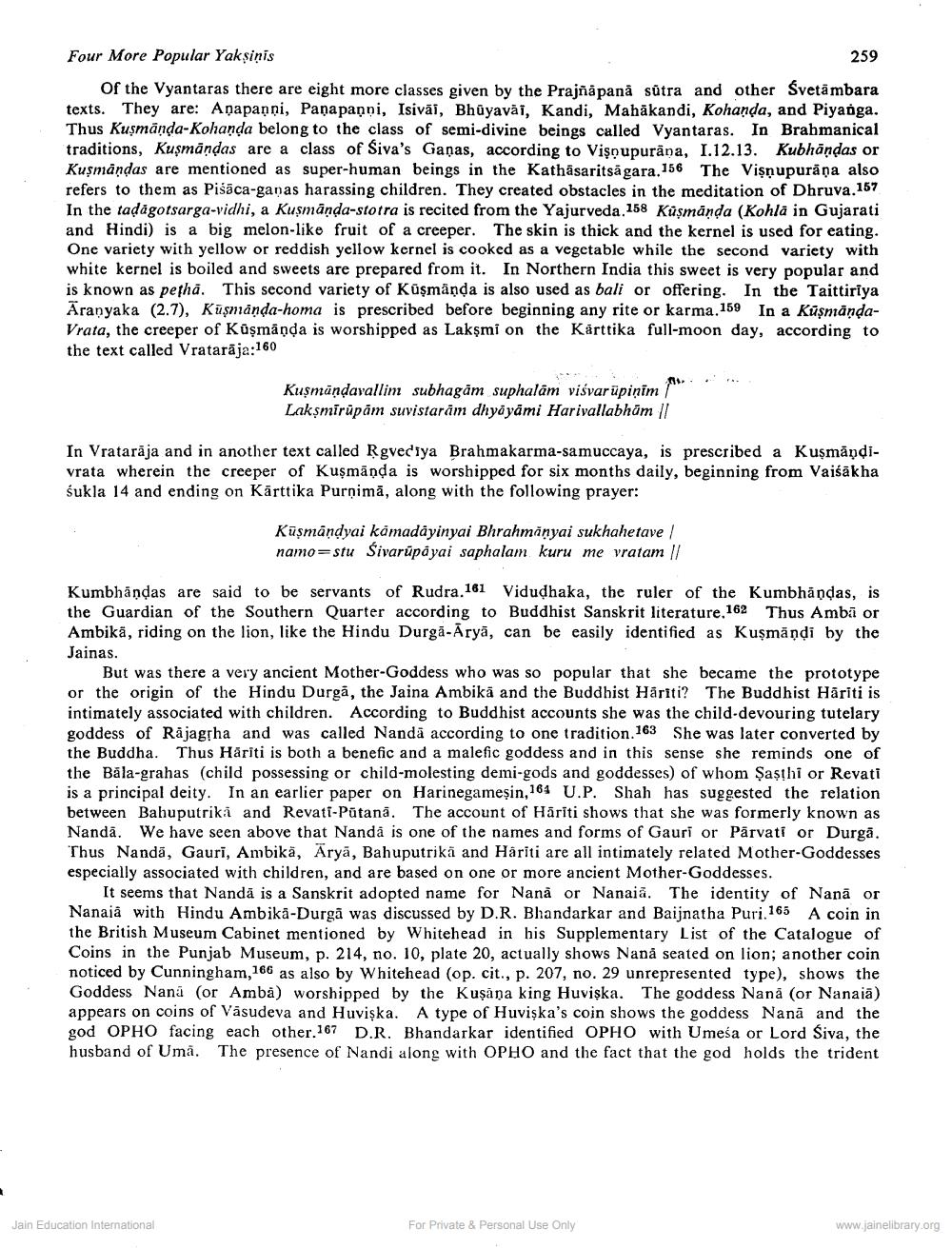________________
Four More Popular Yakṣiņis
Of the Vyantaras there are eight more classes given by the Prajñā panā sūtra and other Svetambara texts. They are: Anapanni, Panapaņņi, Isivai, Bhūyavai, Kandi, Mahakandi, Kohaṇḍa, and Piyanga. Thus Kuṣmaṇḍa-Kohanda belong to the class of semi-divine beings called Vyantaras. In Brahmanical traditions, Kuşmāṇḍas are a class of Siva's Ganas, according to Visnupurana, I.12.13. Kubhāṇḍas or Kuşmandas are mentioned as super-human beings in the Kathasaritsagara. 156 The Viṣṇupurāņa also refers to them as Pisaca-ganas harassing children. They created obstacles in the meditation of Dhruva.157 In the taḍāgotsarga-vidhi, a Kuṣmāṇḍa-stotra is recited from the Yajurveda.158 Küṣmaṇḍa (Kohla in Gujarati and Hindi) is a big melon-like fruit of a creeper. The skin is thick and the kernel is used for eating. One variety with yellow or reddish yellow kernel is cooked as a vegetable while the second variety with white kernel is boiled and sweets are prepared from it. In Northern India this sweet is very popular and is known as petha. This second variety of Küşmaṇḍa is also used as bali or offering. In the Taittiriya Aranyaka (2.7), Kūṣmaṇḍa-homa is prescribed before beginning any rite or karma. 159 In a KūṣmāṇḍaVrata, the creeper of Kūṣmaṇḍa is worshipped as Laksmi on the Kärttika full-moon day, according to the text called Vratarāja:160
Kusmindavallim subhagam suphalām viśvarüpiṇīm Lakṣmīrūpām suvistarām dhyāyāmi Harivallabhām ||
In Vrataraja and in another text called Rgvediya Brahmakarma-samuccaya, is prescribed a Kuṣmaṇḍivrata wherein the creeper of Kuṣmaṇḍa is worshipped for six months daily, beginning from Vaisakha śukla 14 and ending on Kärttika Purnima, along with the following prayer:
Kūṣmaṇḍyai kamadayinyai Bhrahmanyai sukhahetave | namo stu Śivarūpāyai saphalam kuru me vratam ||
259
Kumbhāṇḍas are said to be servants of Rudra.161 Vidudhaka, the ruler of the Kumbhāṇḍas, is the Guardian of the Southern Quarter according to Buddhist Sanskrit literature, 162 Thus Ambā or Ambika, riding on the lion, like the Hindu Durga-Arya, can be easily identified as Kuṣmaṇḍi by the Jainas.
Jain Education International
But was there a very ancient Mother-Goddess who was so popular that she became the prototype or the origin of the Hindu Durga, the Jaina Ambika and the Buddhist Hariti? The Buddhist Hāriti is intimately associated with children. According to Buddhist accounts she was the child-devouring tutelary goddess of Rajagṛha and was called Nanda according to one tradition. 163 She was later converted by the Buddha. Thus Hariti is both a benefic and a malefic goddess and in this sense she reminds one of the Bala-grahas (child possessing or child-molesting demi-gods and goddesses) of whom Şaşthi or Revati is a principal deity. In an earlier paper on Harinegameşin, 164 U.P. Shah has suggested the relation between Bahuputrika and Revati-Putana. The account of Hariti shows that she was formerly known as Nanda. We have seen above that Nanda is one of the names and forms of Gauri or Parvati or Durgā. Thus Nanda, Gauri, Ambikā, Ārya, Bahuputrika and Hariti are all intimately related Mother-Goddesses especially associated with children, and are based on one or more ancient Mother-Goddesses.
It seems that Nanda is a Sanskrit adopted name for Nana or Nanaia. The identity of Nana or Nanaia with Hindu Ambika-Durgā was discussed by D.R. Bhandarkar and Baijnatha Puri. 165 A coin in the British Museum Cabinet mentioned by Whitehead in his Supplementary List of the Catalogue of Coins in the Punjab Museum, p. 214, no. 10, plate 20, actually shows Nana seated on lion; another coin noticed by Cunningham,166 as also by Whitehead (op. cit., p. 207, no. 29 unrepresented type), shows the Goddess Nana (or Amba) worshipped by the Kuṣāņa king Huviska. The goddess Nanā (or Nanaiā) appears on coins of Vasudeva and Huvişka. A type of Huviska's coin shows the goddess Nana and the god OPHO facing each other.167 D.R. Bhandarkar identified OPHO with Umesa or Lord Siva, the husband of Uma. The presence of Nandi along with OPHO and the fact that the god holds the trident
For Private & Personal Use Only
www.jainelibrary.org




